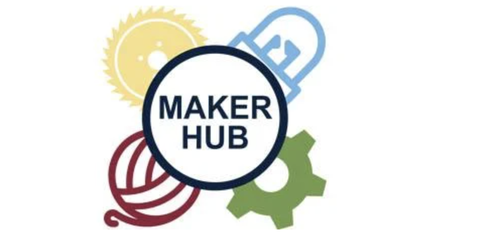Maker Hub

Why Use the Maker Hub?
The Maker Hub, located on the first floor in Lauinger Library, provides a collaborative space for innovation, design, prototyping, and fabrication. The growth of academic makerspaces like the Maker Hub has been driven by the need for accessible technology and the availability of design tools, reflecting a broader movement toward hands-on, project-based learning (Wilczynski et al, 2017). Founded on the educational concepts of constructivism and constructionism, makerspaces place students at the heart of learning, where they can participate in experiential learning by doing and building (Pallaris et al., 2022). Spaces like Georgetown’s Maker Hub have been shown to foster creativity through multidisciplinary collaboration, carefully choosing pedagogy, and not restricting students’ imaginations (Soomro et al., 2023). By cultivating an interdisciplinary environment of experimentation and discovery, makerspaces help develop critical thinking and problem-solving skills.
What Can I Do There?
The Maker Hub includes a wide range of technologies and equipment, including 3-D printers, laser cutters, woodworking tools, electronics equipment, LEGOs, sewing machines, printing presses, and more. Working with staff and volunteers at the Maker Hub, faculty can design hands-on and experiential learning opportunities in their courses and work with the Maker Hub to integrate academic studies through hands-on, project based learning. Students can develop a physical product, prototype, or creative work with the fabrication equipment in response to an assignment.
While research on makerspaces often emphasize their benefits to STEM education (Reynaga-Peña et al., 2020), maker spaces located in academic libraries can provide disciplinary neutral ground. The inclusion of arts and craft supplies, in addition to electronics, promotes more inclusive, multidisciplinary collaborative spaces that can be embraced by both the arts and the sciences (Wong & Partridge, 2016).
The Maker Hub provides space for students to learn, explore, experiment, problem solve, design, and build. The Hub staff routinely works with Georgetown faculty, helping them enhance their curriculum through Maker activities, tours, lectures, and guided conversations on the impact of Makers and Maker Culture on their field of study. The Maker Hub also provides space and materials for students to use fabrication tools to make creative products, such as handcrafted journals and laser-cut Georgetown maps. The Hub is also widely used outside of the classroom as a creative outlet for students, faculty, and staff to relieve stress and build community.
Video overview and tour of the Maker Hub.
How Faculty Use the Maker Hub
Several examples of faculty incorporating the Maker Hub’s resources are highlighted on this curriculum integration page. We’ve highlighted three examples below.
SFS: Science, Technology, and International Affairs Program (STIA)
Professor Clare Fieseler in the School of Foreign Service had students in her course, The Science of Extinction & De-Extinction, create 3-D printed replicas of fossils from 3-D scans made by the Smithsonian. She worked with the Maker Hub to co-design lab activities for her students to learn the methods and applications of 3-D scanning and printing and create 3-D replicas that they used to compare to real life marine mammal fossils from the Smithsonian collection.
Art
Students in professor Toni-Lee Sangastiano’s Intro to Graphic Design course created music event posters based on a song of their choice.
More about the assignment:
“As part of the history of postmodernism, students had to incorporate 1-2 manual/DIY approaches to the imagery into their poster (linocut, embossed label maker, photocopy, ripped or torn edges, typewriter text, etc.) and in the spirit of postmodern hybridity, blend with Maker Hub technology. These textures or elements were scanned or photographed and integrated within their poster using Adobe Software.”
School of Medicine
As a student in Professor Nazaneen Grant’s course, Alan Balu (COL '21, MD '25) developed a fully-open source, 3-D-printed simulator for practicing micro-laryngeal surgery.
Get Started
You can learn more about the resources and opportunities in the Maker Hub by visiting their website at library.georgetown.edu/makerhub, stopping by the Maker Hub on the first floor of Lauinger Library during their Open Hours, or emailing makerhub@georgetown.edu.
For a consultation on how to use the Maker Hub in your course design, please contact CNDLS.
Get Help
Contact the Maker Hub
Contact CNDLS
Resources
Pallaris, G., Zaphiris, P., & Parmaxi, A. (2022). Mapping the landscape of Makerspaces in higher education: An inventory of research findings. Interactive Technology and Smart Education, 21(1), 1–20. https://doi.org/10.1108/ITSE-01-2022-0013
Reynaga-Peña, C. G., Myers, C., Fernández-Cárdenas, J. M., Cortés-Capetillo, A. J., Glasserman-Morales, L. D., & Paulos, E. (2020). Makerspaces for inclusive education. In M. Antona & C. Stephanidis (Eds.), Universal Access in Human-Computer Interaction. Applications and Practice (Vol. 12189, pp. 246–255). Springer International Publishing. https://doi.org/10.1007/978-3-030-49108-6_18
Soomro, S. A., Casakin, H., Nanjappan, V., & Georgiev, G. V. (2023). Makerspaces fostering creativity: A systematic literature review. Journal of Science Education and Technology, 32(4), 530–548. https://doi.org/10.1007/s10956-023-10041-4
Wilczynski, V., Wigner, A., Lande, M., & Jordan, S.S. (2017). The Value of Higher Education Academic Makerspaces for Accreditation and Beyond. Planning for higher education, 46, 32.
Wong, A., & Partridge, H. (2016). Making as learning: Makerspaces in universities. Australian Academic & Research Libraries, 47(3), 143–159. https://doi.org/10.1080/00048623.2016.1228163




